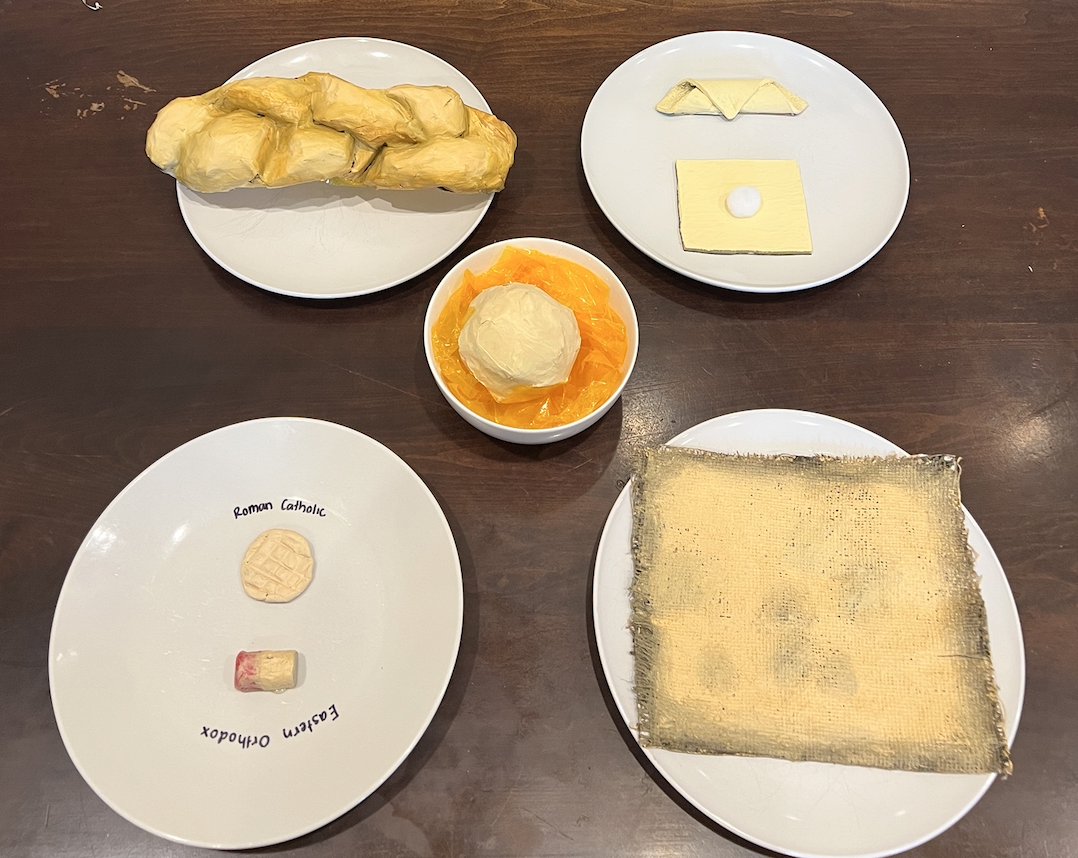Guinevere Keith
Guinevere designed an interactive sculpture exhibit displaying how different Abrahamic communities use bread to teach the stories of their faith. As a passionate bread lover and interfaith student, Guinevere designed this project with the intention of highlighting how something as simple as bread can bring different communities together. Her research documented how challah, matzo, matzo ball soup, resurrection rolls, and communion wafers are used by Jewish or Christian communities to teach religious histories, celebrate important holidays, or engage in rituals. The sculptures are made of recycled materials and on the bottom of each plate is a description of each delicacy’s significance to the faith community from which it originated.
Challah: painted paper maché and masking tape. Jewish communities eat Challah not only for its delicious light texture, but also as a representation of how something physical can be made spiritual. The twelve humps of the bread’s braid represent the miracle of the twelve loaves for the twelve tribes of Israel.
Matzo: painted burlap and glue solution. Matzo is an unleavened bread that Jewish communities eat during the holiday Passover to commemorate their exodus from Egypt. As the Jews had to flee quickly, they did not have time to allow their bread to rise. Matzo is eaten during this holiday to teach this important Jewish religious history and connect modern Jewish people to their ancient roots through this holiday tradition.
Matzo ball soup: painted paper maché, cellophane, and wire. A popular Ashkenazi dish, matzo ball soup is made from the aforementioned matzo as another way of consuming this bread from Jewish religious history. As the holiday of Passover prohibits the consumption of leavened bread as part of its observation, some Jewish people choose to consume matzo in the form of matzo ball soup as a symbol of ancient tradition existing in modern ways.
Communion wafers: painted molding clay. These wafers of bread in the Roman Catholic tradition represent to body of Jesus Christ, and are consumed by many Church members as part of the Catholic Mass in Sunday. Eastern Orthodox Catholics often use a spongy bread dipped in wine for this purpose as well. Taking the eucharist symbolizes to many Catholics a connection to Jesus and receive spiritual sustenance.
Resurrection rolls: pained foam and pom-poms. A relatively modern protestant dish originating in the Midwest region of America, resurrection rolls are made out of marshmallows and canned crescent roll dough. They are used as a teaching tool to help children understand Jesus’ disappearance from His tomb and resurrection. A marshmallow is placed on the inside of the crescent roll dough, rolled up, and put into the oven. When the croissants emerge, the marshmallow will have melted and no longer be visible within the tasty treat. This yummy metaphor for Jesus’ resurrection is gaining popularity with Christians in America.
